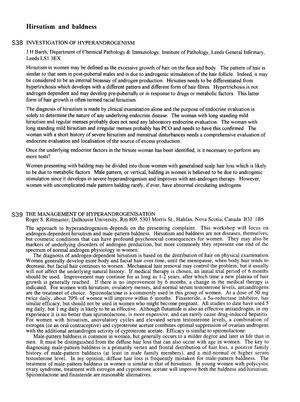Hirsutism and Baldness
March 1997
in “
Journal of Endocrinology/Journal of endocrinology
”

TLDR Excessive hair growth in women can be treated with medications like spironolactone and finasteride, and male-pattern baldness in women can be improved with similar treatments.
The document from 1997 discusses hirsutism, defined as excessive hair growth in women with a pattern similar to post-pubertal males due to androgenic stimulation, and baldness, particularly male-pattern baldness in women. It differentiates hirsutism from hypertrichosis, which is not androgen-dependent. The diagnosis of hirsutism is clinical, and endocrine evaluation is to identify any underlying endocrine disease. Women with mild hirsutism and regular menses may not need laboratory evaluation, while those with irregular menses likely have polycystic ovary syndrome (PCO) and require confirmation. Severe hirsutism with menstrual disturbances necessitates a comprehensive endocrine evaluation. For treatment, an initial 6-month trial of medical therapy is suggested, with antiandrogens like spironolactone and finasteride being effective for many women. A combination of estrogen and cyproterone acetate is recommended for women with anovulatory cycles and elevated serum testosterone. Male-pattern baldness in women, which is less severe and occurs later than in men, should be distinguished from diffuse hair loss and is treated similarly to hirsutism. Estrogen and cyproterone acetate can improve baldness and hirsutism in young women with PCO, with spironolactone and finasteride as alternatives.